Global rigid packaging market is estimated to be valued at USD 238.30 Bn in 2025 and is expected to reach USD 331.08 Bn by 2032, exhibiting a compound annual growth rate (CAGR) of 4.8% from 2025 to 2032.
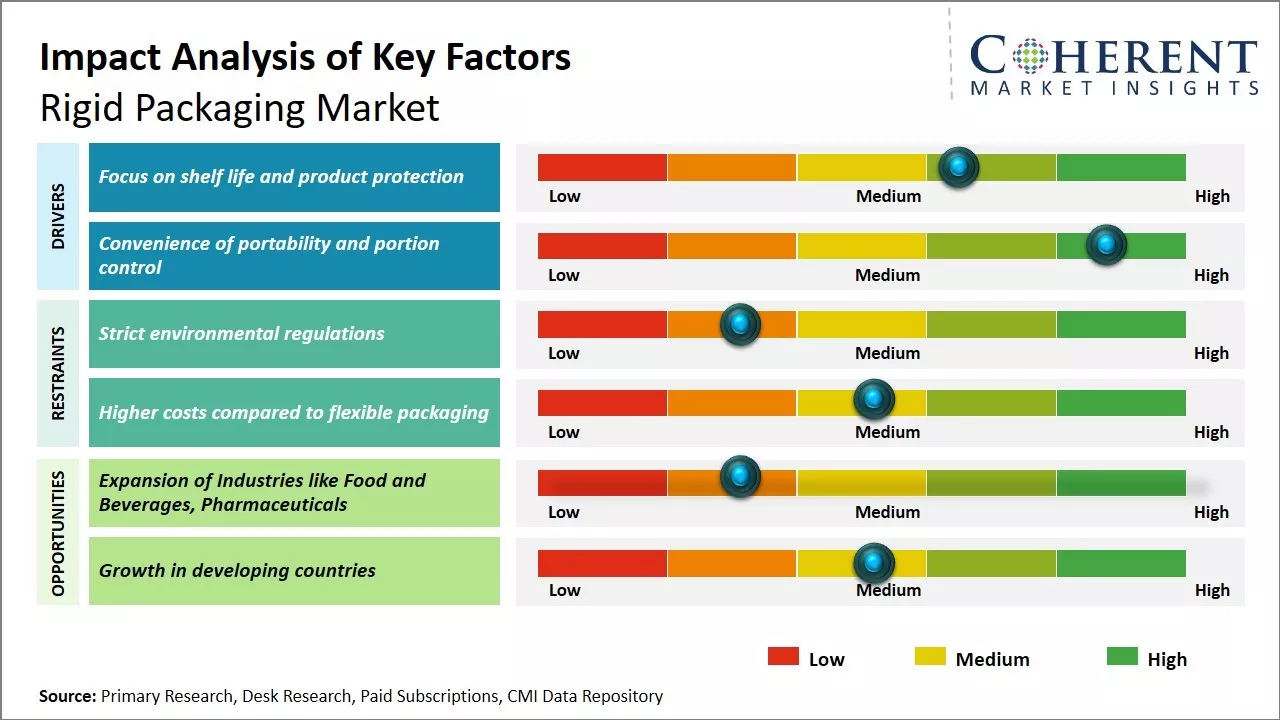
Discover market dynamics shaping the industry: Request sample copy
The market is experiencing positive growth due to increasing demand for packaged food and beverages globally. Rising preference of consumers towards packaged products due to changing lifestyles and growing busy schedules has propelled the sales of rigid packaging. Moreover, the burgeoning e-commerce industry has significantly contributed to the market expansion over the years. Swift globalization and increasing adoption of western consumption patterns in developing regions are some of the key underlying factors accelerating the rigid packaging market trends going forward.
Focus on shelf life and product protection
One of the key drivers for the rigid packaging market is the need for longer shelf life and effective product protection. Rigid packaging plays a vital role in preserving the quality and freshness of packaged goods for extended periods without refrigeration. The use of rigid materials like glass, metal, rigid plastics, and others prevent contents from being damaged due to external factors like pressure, moisture, microorganisms during transportation and storage. Rigid packaging provides superior barrier protection as compared to flexible packaging formats. Glass and rigid plastic containers completely seal food products against air and moisture. Metal cans effectively block oxygen and prevent corrosion. This ability to create an impenetrable barrier is crucial for products that have a higher risk of spoilage. Packaged foods, beverages, healthcare products often needs to remain unchanged for several weeks or months before consumption. The integrity offered by rigid materials against external contamination go a long way in extending shelf life without preservatives. Furthermore, the robust nature of rigid packaging protects fragile contents from damage during distribution activities involving rigorous handling and stacking of packages on shelves, trucks, warehouses, and others. Contents are well-insulated in rigid shells that can withstand accidental bumps and drops. This reduces losses due to product breakage. Manufacturers especially prefer rigid containers for products that need to bear the pressure of transporting and stacking of heavy packages. Industries such as food, beverages and household chemicals leverage the durability of rigid packaging for safely delivering products to customers through multi-step supply chains. Growing food industry is expected to drive the market growth.
For instance, according to the data published by Invest India in 2022, the Indian Food Processing market is estimated to reach US$ 535 Bn by 2025, exhibiting a compound annual growth rate of 15.2%.
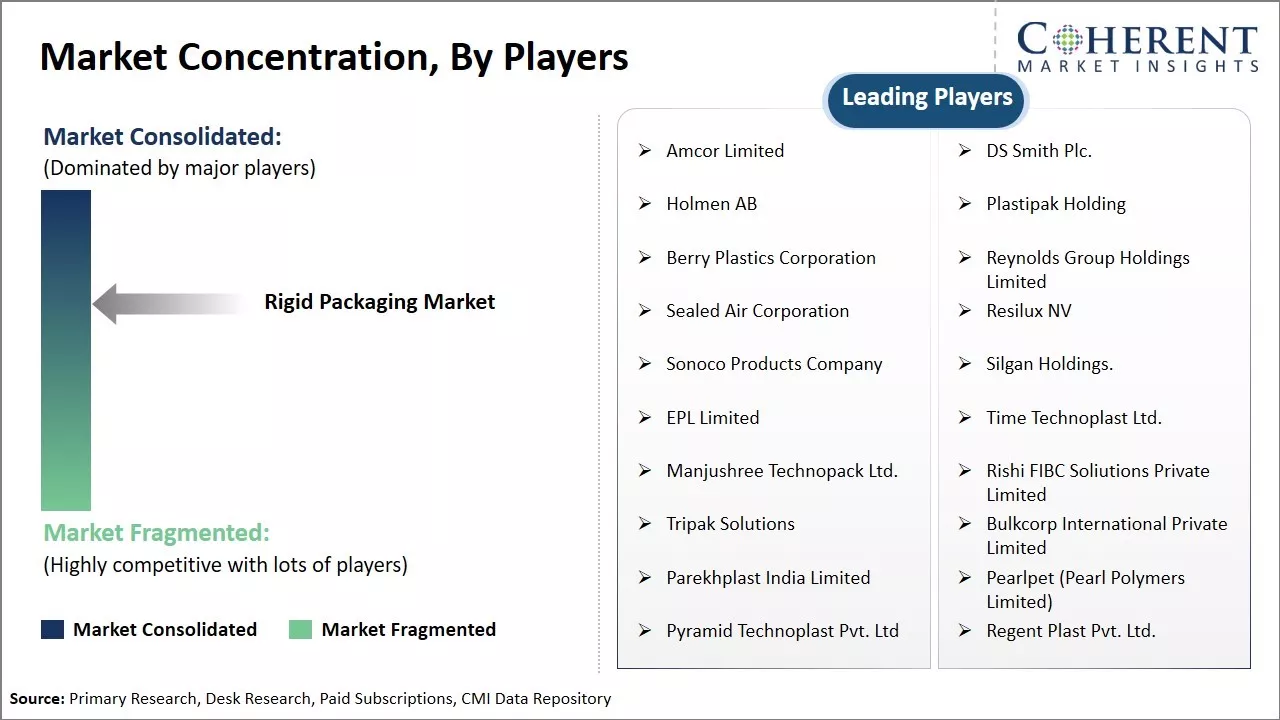
Get actionable strategies to beat competition: Request sample copy
Convenience of portability and portion controlAnother major driver is the convenience offered by rigid packages in terms of portability and portion control. Rigid containers allow measured single-use or single-serve volumes of products to be quickly transported and consumed ‘on-the-go’. Foods, beverages, cosmetics commonly come in rigid cans, bottles, jars or boxes in predetermined amounts. This encourages consumers to purchase in manageable quantities depending on immediate needs. They need not worry about unused portions getting wasted. Rigid packaging with re-closable lids, pour spouts or snap caps allow easy dispensing of exact amounts. Liquids and viscous semi-solids like soup, shampoo, spread, and others can be carried without spillage due to the sturdiness of rigid materials. The rigidity also helps brand owners to differentiate their products.
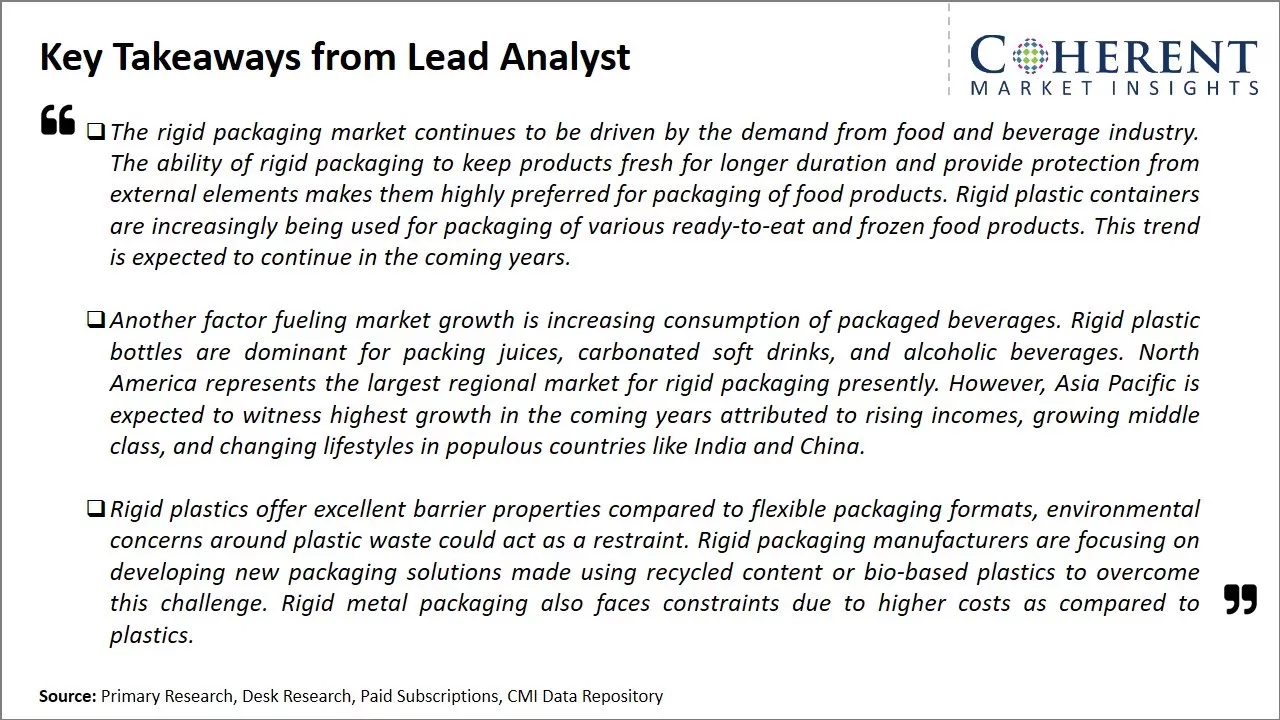
To learn more about this report, Request sample copy
Market Challenges: Strict environmental regulations
Global rigid packaging market faces several challenges. Strict environmental regulations around the world aim to reduce plastic waste which impacts material selection for manufacturers. Volatile raw material prices of resins, paper and metals used in rigid packaging increases production costs. Growing e-commerce has also boosted demand for lightweight and flexible packaging at the expense of rigid packages. Consumer preferences are another challenge as these increasingly demand sustainable and eco-friendly packaging options.
Market Opportunities: Expansion of Industries like Food and Beverages, Pharmaceuticals
The market continues to witness growth due to expansion of industries like food and beverages, pharmaceuticals, and consumer goods. Rigid plastics offer protection to fragile products and help optimize supply chain efficiencies. Technological innovations allow manufacturers to make rigid containers more sustainable and recyclable.
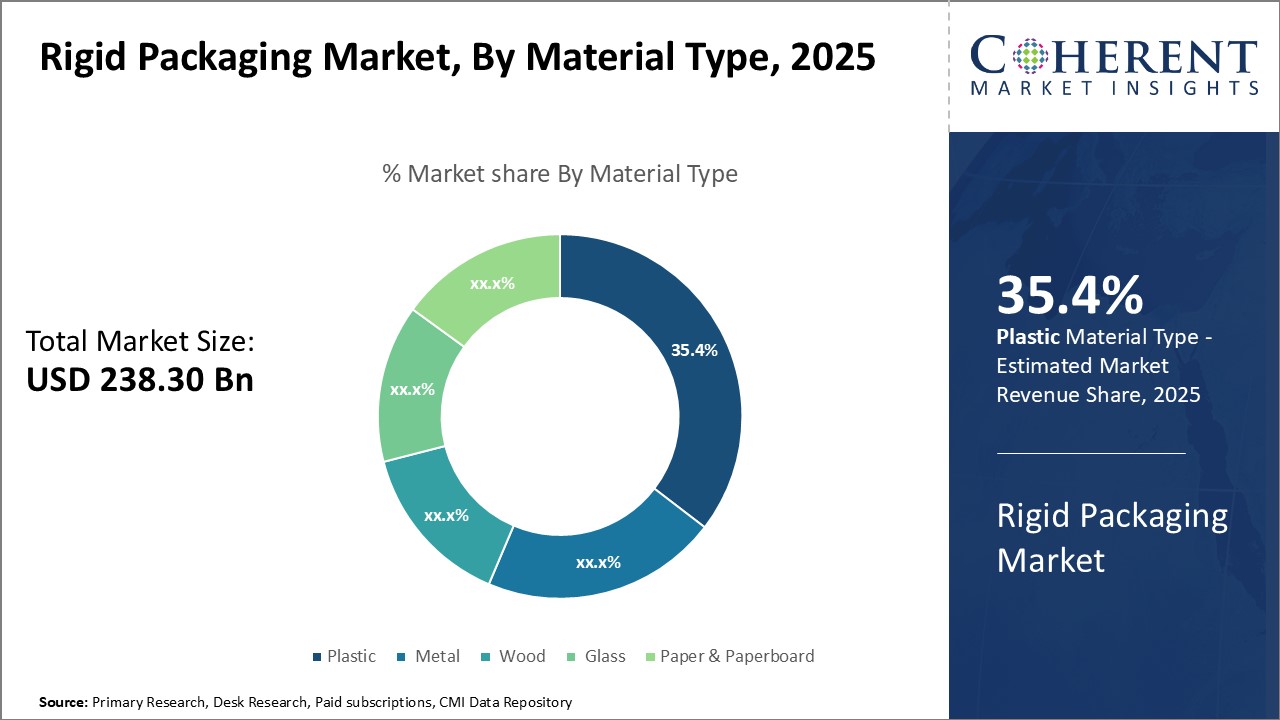
Discover high revenue pocket segments and roadmap to it: Request sample copy
Insights, By Material Type: Rising Demand for Flexibility and Convenience Drives Plastic SegmentIn terms of material type, plastic segment is estimated to contribute the 35.4% share of the market owing to its flexibility and convenience. Properties like lightweight, moldability and low cost of plastic make it a preferred choice for packaging various products. Plastic can be easily molded into any shape and size as per the product requirements. This flexibility allows plastic packaging to efficiently protect products and optimize space during transportation and storage. Plastic is highly durable material and provides effective barrier against moisture, oxygen, and other external elements. This prolongs the shelf life of products and maintains their quality. As consumer preference for longevity and freshness of products increases, demand for plastic packaging is surging across industries. Food producers widely adopt plastic containers, bottles and wraps as these prevent spoilage and contamination. Being lightweight, plastic significantly reduces packaging and shipping costs for manufacturers. Less fuel is consumed to transport plastics packaged products over long distances. This improves profit margins. Lightweight nature also appeals end users as plastic packages are hassle-free to hold and carry. Growing health conscious consumer base favors plastic over other materials for its perceived hygienic qualities.
Insights, By Application: Protecting Perishable Products Augments Food & Beverage Segment
In terms of application, food & beverage segment is estimated to contribute the 51.8% share of the market owing to requirement of rigid packaging for perishable food products. Rigid containers, bottles, jars and other forms of rigid packaging play an essential role in protecting highly perishable food and beverage products from damage, contamination and quality deterioration. Rigid packaging forms an effective barrier against external elements like moisture, oxygen, dust and microorganisms which can easily spoil food. Properties like flex-crack resistance and tamper evidence in rigid packages ensure long shelf life of products during transportation and storage. This allows food producers to distribute products over long distances while maintaining quality and freshness. Rigid containers provide sturdier protection than flexible pouches and bags. These minimize risks of product spillage or leakage during handling. Barrier properties of materials like glass and metal effectively preserve contents of packaged product from air and light. This is critical for products with high moisture content like juices and foods with volatile flavors.
Insights, By Product Type: Protecting Perishable Products Augments Food & Beverage Segment
In terms of product type, containers & cans segment is estimated to contribute the 40.4% of the market share as these offer versatile packaging formats for diverse products. Containers are available in various shapes and sizes suitable for an array of industries like food, healthcare, chemicals and consumer goods. Their rigid structure provides 360-degree product shield during shipping and handling. Cans are preferred for packaging heavy and bulkier products. Two-piece and three-piece cans are economical and high-producing packaging solutions. Growing beverage industry relies on aluminum cans for branding products and ensuring safety of carbonated drinks. Developing cold chain infrastructure increases demand for metal cans that effectively maintain temperatures during transportation. Plastic containers are increasingly replacing glass jars owing to advantages like lightweight and flexibility in sizes. Specialized plastic containers meeting hygienic standards are driving their use in food, dairy, personal care and pharmaceuticals. Bottles have established usage in liquor, edible oils, honey and other liquid packaging needs.
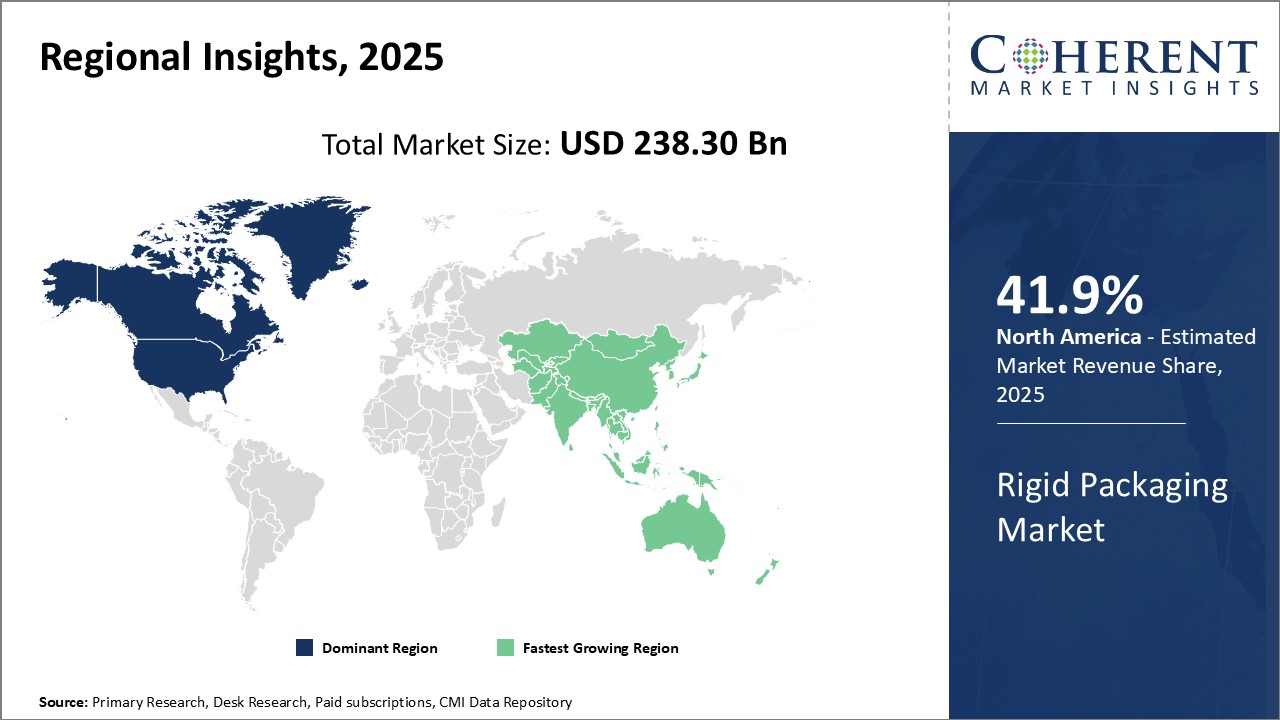
Need a Different Region or Segment? Customize now
North America continues to be a dominant force in the rigid packaging market with 41.9%, led primarily by the United States. The region benefits from high disposable incomes, growing urbanization and an expanding ready-to-eat food market. Major global brands have established their manufacturing and distribution networks in the region to cater to rising demand. This allows them to benefit from economies of scale and efficient logistics. The presence of leading packaging manufacturers provides easy access to high-quality and customized solutions. Ongoing investments in automation and advanced packaging technologies by companies further strengthens the region's position. Stringent health and safety regulations have pushed brands to offer packaged foods with longer shelf-life and tamper-proof seals. This drives the need for innovative rigid materials that can provide effective product protection. Increased preference for smaller packaging sizes also presents opportunities for smaller rigid containers. Demand from industries such as liquor, beer and personal care further augments market revenues. A booming e-commerce industry is introducing new applications for rigid boxes, trays and tubes in the online retail supply chain.
The Asia Pacific region is emerging as the fastest growing market for rigid packaging globally. Rapid urbanization, rising disposable incomes and growth in the middle-class population have spurred the demand for packaged consumer goods. Several multinational companies have established manufacturing bases in countries such as China, India and Vietnam to cater to the expanding local demand as well as gain access to export markets. The availability of raw materials and affordable labor provides a competitive advantage to packaging manufacturers in the region.
Rigid Packaging Market Report Coverage
| Report Coverage | Details | ||
|---|---|---|---|
| Base Year: | 2024 | Market Size in 2025: | USD 238.30 Bn |
| Historical Data for: | 2020 To 2024 | Forecast Period: | 2025 To 2032 |
| Forecast Period 2025 to 2032 CAGR: | 4.8% | 2032 Value Projection: | USD 331.08 Bn |
| Geographies covered: |
|
||
| Segments covered: |
|
||
| Companies covered: |
Amcor Limited, DS Smith Plc., Holmen AB, Plastipak Holding, Berry Plastics Corporation, Reynolds Group Holdings Limited, Sealed Air Corporation, Resilux NV, Sonoco Products Company, Silgan Holdings., EPL Limited, Time Technoplast Ltd. , Manjushree Technopack Ltd., Rishi FIBC Solutions Private Limited, Tripak Solutions , Bulkcorp International Private Limited, Parekhplast India Limited, Pearlpet (Pearl Polymers Limited), Pyramid Technoplast Pvt. Ltd, Regent Plast Pvt. Ltd. |
||
| Growth Drivers: |
|
||
| Restraints & Challenges: |
|
||
Uncover macros and micros vetted on 75+ parameters: Get instant access to report
*Definition: The rigid packaging market includes packaging solutions made from materials like plastic, metal, and glass. These include bottles, cans, jars, containers, and boxes that preserve and protect products during transport and storage. Rigid packaging provides durability, strength and tamper resistance making them suitable for various end-use industries like food and beverages, pharmaceuticals, consumer goods, and personal care. Some key characteristics of rigid packaging are barrier protection from moisture, oxygen, and contaminants which helps extend the shelf-life of products.
Share
Share
About Author
Kalpesh Gharte is a senior consultant with approximately 5 years of experience in the consulting industry. Kalpesh holds an MBA in Operations and Marketing Management, providing him with a strong foundation in market strategy and analysis. He has contributed to various consulting and syndicated reports, delivering valuable insights that support informed business decisions
Missing comfort of reading report in your local language? Find your preferred language :
Transform your Strategy with Exclusive Trending Reports :
Frequently Asked Questions
Joining thousands of companies around the world committed to making the Excellent Business Solutions.
View All Our Clients
US Reciprocal Tax Impact Analysis On Rigid Packaging Market
Stay updated on tariff changes with expert insights and timely information